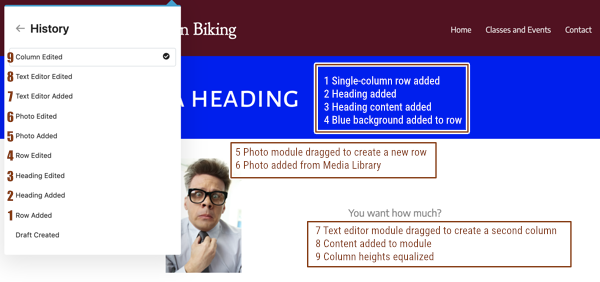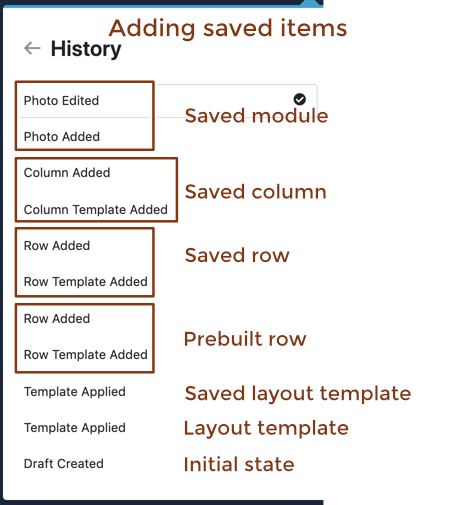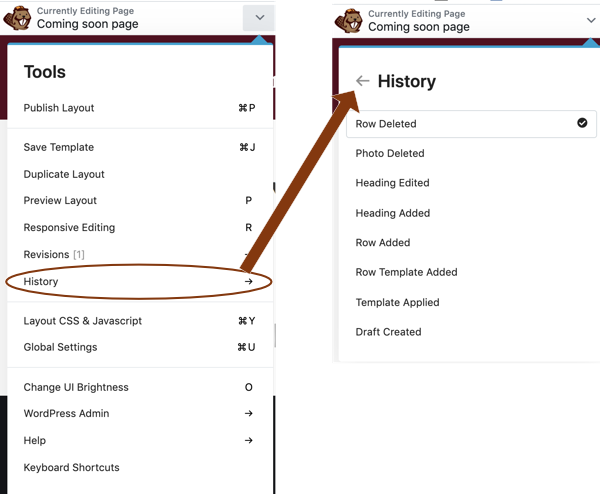Undo and redo
The Lime Editor editor keeps track of editing changes in Lime Editor in a history, recorded at the following level of granularity:
Objects tracked:
- Rows
- Columns
- Modules
- Layout templates and prebuilt rows
- Saved rows, columns, or modules
Events tracked:
- Add
- Edit
- Delete
- Move
- Duplicate
The initial state of the history when you open the editor is Draft created. When you publish or save the layout, the history is erased and the next time you open the Lime Editor editor, the status is once again Draft created.
Examples of editing history
The following screenshot shows an example of the history created with some simple actions in the editor. The sequence of actions is described in the numbered annotations in the layout, matched up with what is recorded in the history.

The dot next to the topmost item shows that the most recent and all previous actions are displayed. As you can see, if you make a number of edits to a row, column, or module at one time, the history shows Edited, so if you undo that item, you'll lose all of the changes you made within that item at that point.
Prebuilt and saved items are also recorded when you add them. The following screenshot shows the actions that are recorded when you add various types of layout templates and saved items:

Notice that when you add saved items, the "added" action is recorded as well as the addition of the actual row. To remove a saved row, column, or module that you've added, you'll need to backstep two items in the history.
To undo and redo
You can undo and redo either by working directly in the History in the Tools menu or by using keyboard shortcuts.
Access the history to undo and redo
- Click History in the Tools menu, as shown in this screenshot.
You can also see an example of items in the history.

- Click any of the items listed in the history and the layout reverts to the layout at that point.
You can keep clicking in the history at various points to undo or restore layout.
You can't pick and choose which items to keep: whatever item you select, that item and the ones lower on the list remain in the layout, while the higher ones are removed.
- When you're done, click Done and then Publish, Save as draft, or Discard.
When you publish the page, the history is reset, so you'll no longer have access to the items that you chose not to keep. If the Save as Draft or Discard your layout, the history remains and you can undo and redo the next time you open the editor. For other implications of saving vs. discarding vs. publishing a page, see this article.
Don't forget you can use the Revisions feature to revert to a previously published version.
Use undo and redo keyboard shortcuts
You can use the undo and redo keyboard shortcuts to step backwards and forwards through the items listed in Tools > History. The keystrokes depend on your operating system, as follows, or within the Lime Editor editor you can find them at Tools > Keyboard shortcuts.
Reduce or disable undo/redo functionality in the editor
The History manager can cause sluggish behavior in the editor, particularly when your site is in a shared hosting environment or the page you're editing has a large number of rows and modules. The default number of changes the History Manager remembers is 20.
You can reduce or disable this number temporarily or more permanently in two ways:
Disable the History Manager temporarily
- Add
&nohistoryto the end of your URL in the Lime Editor editor.
For example:
https://mysite.com/?fl_builder&nohistory
In the editor, if you click History in the Tools menu, you'll see the message Undo/redo history is currently disabled.
Reduce or disable the history by changing wp-config
This method requires access to the wp-config.php file in your WordPress installation root. It reduces or disables the History Manager for all Lime Editor layouts site-wide.
- Open the wp-config.php file for editing.
- Add the following code before the line that says
/* That's all, stop editing! Happy publishing. */:
if ( ! defined( 'FL_BUILDER_HISTORY_STATES' ) ) {
define( 'FL_BUILDER_HISTORY_STATES', 20 );
}
- Change the number of states from
20to a smaller number, or change the number to0to disable the History Manager entirely.
To restore normal History Manager functionality, remove this code from the wp-config.php file.